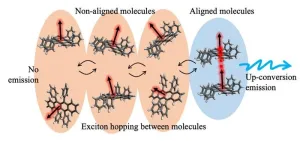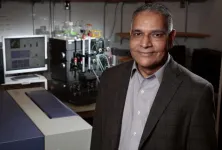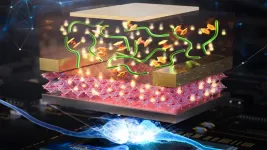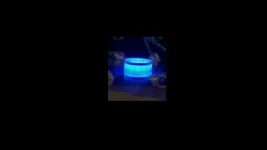(Press-News.org) To combine two low-energy photons into one high-energy photon efficiently, the energy must be able to hop freely, but not too quickly, between randomly oriented molecules of a solid. This Kobe University discovery provides a much-needed design guideline for developing materials for more efficient PV cells, displays, or even anti-cancer therapies.
Light of different colors has different energies and is therefore useful for very different things. For the development of more efficient PV cells, OLED displays, or anti-cancer therapies it is desirable to be able to upcycle two low-energy photons into a high-energy photon, and many researchers worldwide are working on materials for this up-conversion. During this process, light is absorbed by the material and its energy is handed around amongst the material’s molecules as a so-called “triplet exciton.” However, it was unclear what allows two triplet excitons to efficiently combine their energies into a different excited state of a single molecule that then emits a high-energy photon, and this knowledge gap has been a serious bottleneck in the development of such materials.
Kobe University photoscientist KOBORI Yasuhiro and his research group have been working on a property called the “electron spin states” of moving and interacting excited states. They realized that their expertise was exactly what was needed to solve the problem of up-conversion and applied it on a material especially suitable for their analysis. Kobori explains, “In solution systems, it is difficult to observe the magnetic properties of the electron spins due to the high-speed rotation of the molecules, and in conventional solid-state systems, the reaction efficiency is too low for electron spin resonance studies. The thin-film solid-state material used in our study, however, was suitable for observing the magnetic properties of electron spins and generating sufficient triplet exciton concentrations.”
Their results, now published in The Journal of Physical Chemistry Letters, show that for the transfer of energies to one light-emitting molecule, the electron spin states of two triplet excitons have to be aligned, which depends on the relative orientation of the participating molecules. For that to happen with a high likelihood, though, the triplet excitons need to be able to move around between molecules of many different orientations. In addition, this hopping must not be too quick, so there is enough time for the interconversion of different excited states.
The Kobe University researcher lists the steps necessary to arrive at this conclusion. “We first directly observed the time evolution of the electron spin state inside up-conversion materials in solid-state systems, then modeled the observed electron spin motion, and finally proposed a new theoretical model for how the electron spin state relates to the up-conversion process.”
These results finally yield a guideline for how to design highly efficient photon up-conversion materials that is based on the knowledge of the process’s microscopic mechanism. Kobori explains why this excited him. “I expect this knowledge to contribute to the development of high-efficiency solar cells to alleviate our energy problems, but also to expand into a wide range of fields such as photodynamic cancer therapy and diagnostics that utilize near-infrared light for optical up-conversion without harming the human body.”
This work was supported by the Japan Society for the Promotion of Science (grants JP20H05832, JP21H05411, JP22K19008, JP20K21174 and JP22K14648), the Japan Science and Technology Agency (grant JPMJPR2101), and the Yukawa Memorial Foundation. It was conducted in collaboration with a researcher from the Tokyo Institute of Technology.
Kobe University is a national university with roots dating back to the Kobe Commercial School founded in 1902. It is now one of Japan’s leading comprehensive research universities with nearly 16,000 students and nearly 1,700 faculty in 10 faculties and schools and 15 graduate schools. Combining the social and natural sciences to cultivate leaders with an interdisciplinary perspective, Kobe University creates knowledge and fosters innovation to address society’s challenges.
END
How to upcycle low-energy light
2024-03-14
ELSE PRESS RELEASES FROM THIS DATE:
Lives could be saved from tropical disease with new rapid test
2024-03-14
Globally, more than half of patients die after infection with the neglected tropical disease, melioidosis, often before they are diagnosed1. A new rapid test could save lives by diagnosing patients in hours, rather than several days taken by current bacterial culture methods, meaning they receive the correct antibiotics faster.
The test uses CRISPR to detect a genetic target that is specific to Burkholderia pseudomallei, the bacterium that causes melioidosis, with 93 per cent sensitivity. It was ...
Revolutionary chronic wound treatment could help millions
2024-03-14
Revolutionary chronic wound treatment could help millions
A team of international scientists has developed an effective treatment for preventing infection in chronic wounds that does not involve antibiotics
The treatment involves the plasma (electrical gas) activation of hydrogel dressings to produce a unique mix of different chemical oxidants that applied to the wound are effective in decontaminating and aiding healing in chronic wounds
The new method is a significant advance that could revolutionise the treatment of diabetic foot ulcers and internal wounds
More than 540 million people ...
First-of-its-kind super minigene to boost spinal muscular atrophy research
2024-03-13
AMES, Iowa – Ravindra Singh has spent years studying a gene that when missing or mutated causes spinal muscular atrophy (SMA), a deadly disease that’s among the most common genetic disorders in children. His team’s latest work will make the search for treatments even more effective in the years to come.
Singh, a professor of biomedical science at Iowa State University, led an eight-year project to create a truncated version of the Survival Motor Neuron 2 (SMN2) gene to facilitate quicker, cheaper and less fragmented research. Nucleic Acids Research, a peer-reviewed ...
NYU Tandon study exposes failings of measures to prevent illegal content generation by text-to-image AI models
2024-03-13
Researchers at NYU Tandon School of Engineering have revealed critical shortcomings in recently proposed methods aimed at making powerful text-to-image generative AI systems safer for public use.
In a paper that will be presented at the Twelfth International Conference on Learning Representations (ICLR), taking place in Vienna on May 7 - 11, 2024, the research team demonstrates how techniques that claim to "erase" the ability of models like Stable Diffusion to generate explicit, copyrighted, or otherwise unsafe ...
New analysis shows tirzepatide consistently reduces bodyweight regardless of body mass index (BMI) before treatment
2024-03-13
*Note – this is an early press release from the European Congress on Obesity in Venice, Italy 12-15 May. Please credit the congress when using this research*
Tirzepatide, a medication authorised to treat obesity and/or type 2 diabetes, consistently reduces bodyweight regardless of the patient’s body mass index (BMI before treatment), from the range of overweight to class III obesity. The study, to be presented at this year’s European Congress on Obesity (Venice, Italy, 12-15 May) is by Prof Carel Le Roux, University ...
Tirzepatide reduces body weight and waist circumference in people living with overweight or obesity regardless of duration of their condition
2024-03-13
*Note – this is an early press release from the European Congress on Obesity in Venice, Italy 12-15 May. Please credit the congress when using this research*
New research to be presented at this year’s European Congress on Obesity (Venice, Italy, May 12-15) shows that the obesity medication tirzepatide consistently reduces bodyweight and waist circumference regardless of the length of time the person has been living with overweight or obesity. The study is by Dr Giovanna Muscogiuri, University of Naples Federico II, Naples, Italy, and colleagues.
Tirzepatide (Mounjaro®) was approved by the US Food and ...
Scientists use novel technique to create new energy-efficient microelectronic device
2024-03-13
Breakthrough could help lead to the development of new low-power semiconductors or quantum devices.
As the integrated circuits that power our electronic devices get more powerful, they are also getting smaller. This trend of microelectronics has only accelerated in recent years as scientists try to fit increasingly more semiconducting components on a chip.
Microelectronics face a key challenge because of their small size. To avoid overheating, microelectronics need to consume only a fraction of the electricity of conventional electronics while still operating at peak performance.
Researchers at the U.S. Department of Energy’s (DOE) Argonne National Laboratory ...
Jay Sexton receives 2024 SEC Faculty Achievement Award
2024-03-13
COLUMBIA, Mo. — In fourth grade, Jay Sexton first encountered one of James McPherson’s most influential works, “Battle Cry of Freedom: The Civil War Era.” That experience would ignite a lifelong passion for studying history and establish an ongoing legacy as a preeminent scholar in the study of the American story.
As director of the Kinder Institute on Constitutional Democracy at the University of Missouri — a world-renowned academic center devoted to the study of the American founding, including constitutional ...
Canada Research Chair awarded to finance professor at the Rotman School of Management
2024-03-13
Toronto – A leading academic expert in household finance, Claire Célérier, who is an associate professor of finance at the University of Toronto’s Rotman School of Management, has been named by the Government of Canada as the Canada Research Chair in Household Finance.
Prof. Célérier’s research explores how finance can benefit households, investigating the role of innovation and the impact on diversity and inclusion. She addresses these questions taking different ...
Water droplet spun by sound screens for colon cancer
2024-03-13
DURHAM, N.C. – Mechanical engineers at Duke University have devised a new type of diagnostic platform that uses sound waves to spin an individual drop of water up to 6,000 revolutions per minute. These speeds separate tiny biological particles within samples to enable new diagnostics based on exosomes.
A very light disc placed on top of the spinning drop features etched channels that are equipped with star-shaped nanoparticles tailored to enable the label-free detection of specific disease-relevant bioparticles called exosomes. The technique ...







